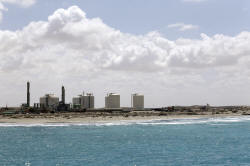Oil rises after record Chinese imports but threat of
oversupply grows
 Send a link to a friend
Send a link to a friend
 [November 08, 2018]
By Amanda Cooper [November 08, 2018]
By Amanda Cooper
LONDON (Reuters) - Oil rose on Thursday,
recovering modestly from this week's three-week lows, after record
Chinese crude imports soothed some concern that demand in the world's
largest commodity buyer may be flagging just as global supply is rising.
Record U.S. crude production and signals from Iraq, Abu Dhabi and
Indonesia that output will grow more quickly than expected in 2019
pushed the price of Brent oil to its lowest since mid-August earlier in
the week.
Brent crude futures rose 71 cents to $72.78 a barrel by 1007 GMT, while
U.S. crude futures gained 55 cents to $62.22.

"Crude oil prices are being supported by a jump in October Chinese crude
oil imports ... thirst for the black stuff has increased amongst
domestic teapot refiners," PVM Oil Associates strategist Tamas Varga
said.
China's crude imports rose 32 percent in October compared with a year
earlier to 9.61 million barrels per day (bpd), customs data showed on
Thursday.
"Crude oil imports rose ... as uncertainty around tariffs on U.S.
imports and sanctions on Iran eased," ANZ bank said.
Tempering some of the enthusiasm was data showing U.S. output reached a
new record high of 11.6 million bpd, and a forecast that it would grow
far more quickly next year than many previously expected.
[to top of second column] |

A general view of the
Zueitina oil terminal is seen in Zueitina, west of Benghazi April 7,
2014. REUTERS/Esam Omran Al-Fetori

The United States has now surpassed Russia to become the world's largest oil
producer and the Energy Information Administration said this week it expects
output to top 12 million bpd by the middle of 2019, thanks to shale oil.
Production has not just risen in the United States, but also in many other
countries, including Russia, Saudi Arabia, Iraq and Brazil, and threatens to
overtake demand next year.
Even with U.S. sanctions on Iranian oil in place, the perception among investors
is that there is more than enough supply to meet demand, as reflected by the
front-month January Brent futures contract trading at a discount to February.
This price structure, known as contango, materializes when traders and investors
believe supply to be greater than demand and therefore have more incentive to
store oil, rather than sell it, thereby creating an even larger pool of unsold
crude.
"OPEC and Russia may use cuts to support $70 per barrel," said Ole Hansen, head
of commodity strategy at Saxo Bank.
(Additional reporting by Henning Gloystein in SINGAPORE; Editing by Dale Hudson)
[© 2018 Thomson Reuters. All rights
reserved.] Copyright 2018 Reuters. All rights reserved. This material may not be published,
broadcast, rewritten or redistributed.
Thompson Reuters is solely responsible for this content.
 |